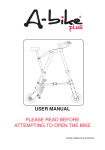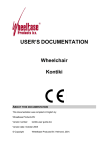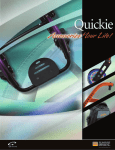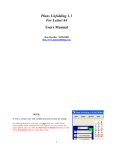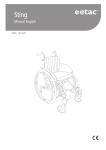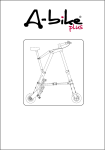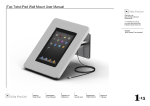Download User manual - Wheelchair Review
Transcript
User manual Rigid frame wheelchairs / English #/.4%.43 Title Page 1. General.......................................................................................................... 3 2. Handling/Transport....................................................................................... 4 3. 4. Product description Act.................................................................................. Model Act...................................................................................................... 5 6 5. Options and accessories.................................................................................. 7 6. 7. 8. 9. Settings Seat.................................................................................... Backrest............................................................................. Footrest.............................................................................. Operating Conditions........................................................ 8-11 12 13 14-20 10. Assembly instructions accessories.................................................................. 21-24 11. Care and maintenance................................................................................... 25-26 12. Tests and guarantees...................................................................................... 27 13. Alternative seat height/angles........................................................................ 28 14. Weights and measurements/ Standard model................................................ 29 This manual is valid from October 2004 and replaces the previously published manual. Art nr: 74066C 04-10-20 2 '%.%2!, The manual should be studied carefully before assembly and use to avoid damage to your Act wheelchair. is a warning triangle to indicate that special care should be taken. (!) gives special advice and tips. Anti-tip is an accessory. At the correct setting it will prevent the chair falling backwards. We recommend that the anti-tip be used unless you are an experienced user with absolute control over your wheelchair. Act is an allround wheelchair which is intended for use both indoors and out. It is tested and approved in accordance with ISO standard 7176. The tests are carried out by the Handicap Institute of Sweden, Tuv in Germany and Tno in Holland. Testing Etac wheelchairs are tested in accordance with ISO 7176-19 and 10542. These ISO standards specify requirements for the design of the wheelchair restraint points and describe how the wheelchair and user are secured in the vehicle, as well as describing how testing should be carried out and how the test results should be interpreted. Etac wheelchairs are crash-tested by the Swedish National Testing and Research Institute. The tests were carried out with the wheelchairs in their standard configurations (see manual for respective wheelchair) together with a restraining device, UNWIN_WWR/ ATF/K/R, and a three-point seat belt, UNWIN_WWR/HD/ATF/K/R. The following wheelchairs passed the tests in accordance with ISO 7176:19 and ISO 10542: Act (Ser.No. 21A), Elite (Ser.No. 10D), Sting (Ser.No. 11D). Seat width: From 35 cm to 45 cm. Seat depth: Short frame: 33-39 cm. Long frame: 39-46 cm. Max user weight: 100 kg. Act is delivered with rear wheels unmounted. Lifetime: The wheelchair meets fully the demands and specifications of prEN ISO/11199-2. Etac calculate that this test is equal to 5-6 years normal use of the wheelchair. This means that we judge the normal lifetime of a manual wheelchair to be five years of normal use by one and thesame user. The lifetime of the wheelchair is dependant above all on the type of handicap that the user has, and on the proper degree of maintenance. This means that different users may experience both a shorter and longer wheelchair-lifetime then the above-mentioned. Toolkit consists of: 5 Allen keys: 2, 3, 4, 5, and 6 mm 2 spanners: 10 and 8 mm 1 socket wrench: 24/19 mm 3 (!.$,).'42!.30/24 2:1 Folding - If armrests or sideguards are mounted, they should be removed Remove the rear wheels Fold down the backrest by pulling upwards on the wire. 2:2 Unfolding - Attach the rear wheels Fold up the backrest Attach armrests or sideguards if required When attaching the rear wheels, ensure that they are securely mounted. The button in the hub should pop out completely. 2:3 Lifting the wheelchair - Lift by holding the push handles and the front part of the frame. Before lifting, ensure that the push handles are securely fastened. 2:4 Car transport Private car/taxi: The wheelchair should be placed in the car boot. If this is not possible, ensure that the wheelchair is placed in a seat in such a way that it cannot roll or overturn. If possible, the wheelchair should be secured using a safety-belt. 2:5 Securing The wheelchair must be secured as follows. The straps must not run through the wheels or around the seat back tubes. 4 (!.$,).'42!.30/24 2:6 Seat belt If the wheelchair is used as a seat for travelling in the vehicle Etac recommends that the user wears the three-point seat belt that is fitted to the vehicle. It is important that the three-point seat belt is fitted correctly, as shown in the drawings: 2:7 Recommendations Etac recommends that: - the user transfers to one of the seat’s in the vehicle and wears the vehicle’s three-point seat belt while travelling. - a three-point seat belt is worn. - positioning belt 25668 is used. - a correctly adjusted headrest is used. - the wheelchair is positioned facing forwards and is secured in accordance with the instructions provided by the supplier of the restraining device. - the back of the wheelchair should be level with or above the user’s shoulders when travelling in the vehicle. - the parking brake is used and the anti-topple guard is lowered. 2:8 Warning' - - - The wheelchair positioning belt is inadequate to prevent the user from being thrown out of the wheelchair in the event of sudden braking. The restraining device must not pass through the wheels or around the seat back tubes. Options/accessories that can be removed without tools, such as trays, must be removed and secured or placed where they cannot fly around inside the vehicle in the event of a collision. If a wheelchair was present in a vehicle that has been involved in a collision it should be inspected at the local mobility centre or by Etac before it is used again. 5 02/$5#4$%3#2)04)/.!#4 2 3 1 17 16 4 15 14 5 13 11 12 10 7 6 9 8 1 2 3 4 5 6 7 8 9 Push handles Backrest cover Backrest upholstery Seat upholstery Frame Footrest Calf strap Castor Front fork 10 11 12 13 14 15 16 17 6 Front fork attachment Protective stopper Brake Quick release hub Rear wheel mount Handrim Backrest angle plate Rear wheel 02/$5#4$%3#2)04)/.!#4 ALTERNATIVE MODEL (OPTIONS) STANDARD MODEL Seat adjustable in height and angle Seat adjustable in height and angle Front seat height installed at 48 cm Front seat height installed at 44-54 cm 5" allround castors 6,5" allround castors, 6" pneumatic Front fork medium with 3 alternative height settings for castor Rear seat height installed at 41 cm Front fork medium with 3 alternative heigth settings for castor Rear seat height installed at 41-45 cm Seat depth adjustable 5 cm (upholstery f olded in) 24" rear wheel, quick release hub 24" rear wheel, quick release hub 1" high pressure tyre (with innertube) 1" high pressure tyre (with innertube), 24" Handrim; titanium Handrims;stainless aluminium, friction coated, cellular rubber alt. plastic coated Camber 3° Camber 0° or 6° Backrest adjustable in angle and form Backrest adjustable in angle and form Backrest standard height 40 cm Backrest standard height 38, 36, 34, 32, 30 cm Backrest angle mounted at -8° Backrest angle in alternative positions, -3°, -5°, -8°, -10°, -12° och -15° Adjustable backrest upholstery in velour and plush Footrest Footrest Footrest height infinitely variable Calf strap, adjustable in length High mounted brakes Brake with long handle and short swing 7 !##%33/2)%3 ARMREST swing-away SIDE-GUARD hard, black SIDE-GUARD hard, plexi MUDGUARD folds with the backrest MUDGUARD fabric, black PUSH HANDLE KIT SEAT CUSHION dark grey plush and black velour, 56 cm long, cut to required seat depth, washable ANTI-TIP adjustable in height and length, detachable SPOKE GUARD with grey or yellow logo QUAD WHEEL RELEASE ADAPTER for persons with reduced hand capabilities TOOL KIT CASTOR PIN LOCK /04)/.3 BRAKE LEVER EXTENSION HANDRIMS cellular rubber, aluminium, friction coated, stainless or grey plastic coated 8 3%44).'33%!4 6:1 FRONT SEAT HEIGHT The front seat height (adjustable between 44-54cm) is dependant upon: Castor 5" Front fork attachment Adjustable in angle Front fork Short, medium or long with three alternative heights for the castor. Risk for tipping: always check the positioning of the anti-tip. (!) See also para 13 :”alternative seat height/angle” 6:2 Castor The height may be adjusted by changing the castor itself or by c hanging its position in the front fork. Unscrew the castor and place it at the desired height. Tools: 5 mm Allen key and 10 mm spanner. (!) Also adjust the angle of the front fork attachment, see para 6:4 6:3 Changing the front fork 1 Remove the stopper from the front fork attachment to reach the retaining nut. Unscrew the nut and pull out the front fork. Take the washer from around the fork axle and put it on the new fork (the bevelled side (A) should be towards the fork) It is also important that the washers in the attachment under the retaining nut are in the right order, with the spring washer (B) in the middle. Tighten the retaining nut until it does not turn any more. Loosen it 1/2 - 1 turn. This will ensure that the spring washer has the correct tension, thus reducing the risk of “wobbling”. 2 Tools: 19 mm socket wrench (!) Also adjust the angle of the front fork attachment, see para 6:4 9 3%44).'33%!4 6:4 Setting the angle of the front fork attachment Setting the correct angle is important to the manoeuvrability of the wheelchair. - Unscrew the lower attachment screw (A) 1/2-1 turn, and the upper screw (B) 1/2 a turn. Turn the off-centre nut (C) until the attachment is at 90° to the floor. Hold the nut in place with a spanner whilst the attachment screws are tightened. Tools: (!) 6 mm Allen key and 19 mm spanner. ( a spirit level may be useful). Keep your eye on something vertical, i.e. a doorpost or table leg when setting the angle. This adjustment must be made when the seat height is changed at the front or rear in order to retain the best possible manoeuvrability. 6:5 REAR SEAT HEIGHT The rear seat height is dependant upon: Pos The size of the rear wheel 24" The height setting of the rear wheel : 2 alternatives ; B-C. Risk for tipping: Always check the positioning of the antitip. (!) See also para 13: “Alternative seat heights/angles”. 6:6 Rear wheel with quick release hubs The axle shaft is adjustable in length. Turn the nut on the axle shaft inwards/outwards while at the same time holding the axle with a spanner. When fitting the wheel always ensure that it is properly secured. The button on the hub should pop out completely. 10 C B 41 cm 45 cm 3%44).'33%!4 6:7 Height adjustment of the rear wheel Unscrew the axle sleeves and washers, tilt the rear axle to free it and mount it at the desired height. Mount the rear axle with the larger bevelling towards the right-hand attachment. At the same time as the rear seat height is adjusted, you should make sure that you have achieved the correct centre of balance, see para 9:8. Tools: 21 mm spanner. Ensure that the rear wheel is correctly mounted, see para 6:6. Always check the positioning of the anti-tip. Always adjust the brakes after re-positioning the rear wheels. (!) Adjust the angle of the front fork attachment. 6:8 Adjusting the brakes Pos 1 Pos 2 The brakes are infinitely variable in position. - - Loosen the screws a couple of turns and slide the brake until the brake block is about 20 mm from the tyre when the brake is not applied. If the locking bracket comes into contact with the cross bar, the bracket may be moved from position 1 to position 2. Check the brakes. Tools 5 mm Allen key The effectiveness of the brakes depends upon the air pressure in the tyres. The brakes are parking brakes only and should not be applied when the wheelchair is in motion. 11 Brake-handle extensions are available as accessories, see para 10:7 3%44).'33%!4 6:9 SEAT ANGLE The seat angle is dependant upon the difference between the front and rear seat heights. The seat angle is adjustable between -5°- -10° backwards angle. (0-5 cm) Remember the risk of tipping. Always check the position of the anti-tip. (!) If the seat angle is changed: Adjust the angle of the front fork attachment. Check the position of the backrest. 6:10 SEAT DEPTH The seat depth can be adjusted by tucking in the front part of the seat upholstery. Short frame: 34-39 cm (Measured from the backrest). Long frame: 39-45 cm (Measured from the backrest. (!) The functional seat depth can be up to 6-7 cm longer depending upon the settings of the backrest upholstery, see para 7:4. 12 Seatheight rear Seatheigth front 3%44).'3"!#+2%34 7:1 BACKREST The backrest is adjustable in angle and has adjustable upholstery. Risk for tipping: Always check the position of the anti-tip after adjusting the backrest. 7:2 Backrest height The backrest height is adjustable by cutting the backrest posts. When using the push handles the backrest posts should be cut 10 mm above the upper attachment holes. Alternative heights: 40, 38, 36, 34, 32, 30 cm. 10 mm Tools: Hacksaw (!) When the push handles are attached the backrest posts are 3 cm lower. If it should be necessary to extend a backrest which has previously been cut down, there is available an extension kit with attachments for push handles. Maximum height for a backrest including extension kit is 40 cm. 7:3 Backrest angle B The backrest angle has fixed positions at -3°, -5°, -8°, -10°, -12° and -15°. Remove screw (A) completely, loosen screws (B) one turn. Install the desired angle by inserting screw (A) into the correct angleindicator. Tighten the screws again. A Tools: 4 mm Allen key. (!) Fold the backrest down onto the seat whilst adjusting the angle. You should allow plenty of room for the backrest cover between the seat and the backrest. Risk of tipping: Always check the positioning of the anti-tip after adjusting the backrest angle. 7:4 Backrest upholstery The contour of the backrest upholstery is individually adjustable by using the four Velcro straps and the backrest cover. Allow the cover plenty of room between seat and backrest, so that you can “sit in” against the backrest. Loosen all straps and ensure that the user is sitting as far back in the chair as possible. Tighten the straps so that they follow the contours of the back and give support to the lumbar region. Risk for tipping : Always check the position of the anti-tip after adjusting the backrest upholstery. 13 C 3%44).'3&//42%34 8:1 The height of the footrest Act is delivered with a footrest that is adjustable in height. Height: Loosen the screw (A) on the rear of the footrest attachment, both on the left and right side. Install the desired height. Tighten properly. Max. height: 9 cm from floor level. Min height: 4 cm from floor level. Tools: 6 mm Allen key (!) If a footrest is required which is higher than standard, a raised footrest is available. For outdoor use, the footrest should be at least 5cm over ground level. Never stand on the footrest as the chair may tip! 14 A 3%44).'3/0%2!4).'#/.$)4)/.3 9:1 OPERATING CONDITIONS Weight distribution is the decisive factor when it comes to operat-ing conditions. It is in part dependant upon the user’s weight, size and seating position, and in part upon the position of the rear-wheels. The more weight that is placed above the rear wheels, the easier the wheelchair is to manoeuvre. If more weight is placed over the castors, the chair becomes heavier to drive. Act standard model is delivered with a 3° camber. This means that the wheels are a little closer to the seat and backrest on top and are wider apart at floor level. This gives several advantages: The wheelchair turns more easily holds a steady course has a broader support base allows the user to hold his arms closer to his body when driving forwards, giving more strength to each push. If you require a chair that is slightly narrower Act can be ordered with a straight back axle ( 0°camber). Act can even be supplied with double back axles - 0° and 3° camber. Helper : If the user is left alone in the wheelchair, ensure that the brakes are applied and that the anti-tip is swung down. Parking: Increase the overall support base of the wheelchair by reversing about 10cm, thereby ensuring that the castors swing forwards. 9:2 OPERATING CONDITIONS : Kerbs and raised thresholds: up User alone, driving up forwards: This method is recommended only for experienced wheelchair users. Ensure that the anti-tips are turned upwards. Drive forward to the edge of the kerb/threshold. Balance the wheelchair on its rear wheels so that the castors lift high enough off the ground to clear the obstacle. Push firmly forwards on the handrims while at the same time leaning forwards with your upper body. Be sure to turn the anti-tip back to the down position. 15 3%44).'3/0%2!4).'#/.$)4)/.3 Assistant, driving up forwards: Ensure that the anti-tips are turned upwards. Tilt the wheelchair, with help from the tipper bar, so that the castors lift height enough to clear the obstacle. Lift by the push handles to help the rear wheels over the obstacle. Be sure to turn the ant-tip back to the down position. User alone, driving up backwards: This method works only if the obstacle is low, relative to the installed height of the footrests. Ensure that the anti-tip is turned upwards Reverse the chair until the rear wheels meet the obstacle. Push back firmly and strongly on the handrims while at the same time leaning the upper body forwards. Be sure to turn the anti-tip back to the down position. Assistant, driving up backwards: - Reverse the chair until the rear wheels meet the obstacle. Tilt the chair, with help from the tipper bar, so that the castors are off the ground. Pull the wheelchair upwards and backwards, ensuring that the castors have cleared the obstacle before setting down the wheelchair onto all four wheels. Be sure to turn the anti-tip back to the down position. 9:3 OPERATING CONDITIONS: Kerbs: down User alone, driving down forwards: This method is recommended only for the experienced wheelchair user. Ensure that the anti-tip is turned upwards. Drive forwards to the edge of the kerb. Push forwards firmly and strongly on the handrims so that the wheelchair lands below the kerb on all four wheels simultaneously. Be sure to turn the anti-tip back to the down position Assistant, driving down forwards: Ensure that the anti-tip is turned upwards. Tilt the wheelchair, with help from the tipper bar, so that the castors lift off the ground. Drive carefully down the kerb and set down the castors onto the ground again. Be sure to turn the anti-tip back to the down position.. 16 3%44).'3/0%2!4).'#/.$)4)/.3 User alone, driving down backwards: This method is not recommended for obstacles over 10 cm in height. Ensure that the anti-tip is turned upwards. Reverse the chair to the edge of the kerb. Reverse carefully down the kerb while at the same time leaning forwards with the upper body. There is a greater risk of tipping during this manoeuvre Be sure to turn the anti-tip back to the down position. Assistant, driving down backwards: Ensure that the anti-tip is turned upwards. Reverse the chair to the edge of the kerb. Reverse carefully down the kerb and continue backwards, keeping the castors raised until they have cleared the kerb. Set down the wheelchair onto all four wheels. Be sure to turn the anti-tip back to the down position 9:4 OPERATING CONDITIONS: Angled surface. Please read carefully this important advice for driving up or downhill to minimise the risk of tipping. (!) Never attempt a U-turn in the middle of a hill. Hold as straight a course as possible. It is better to ask for help that to take a risk on your own. Uphill driving: Lean forwards to correct your centre of balance. Downhill driving: Lean against the backrest to correct your centre of balance. Control your speed using the handrims; never attempt to apply the brakes while in motion! 17 3%44).'3/0%2!4).'#/.$)4)/.3 9:5 OPERATING CONDITIONS: Staircase up Always ask for help. Never use an escalator, even if you have an assistant. With assistant, backwards: Turn the anti-tip upwards and ensure that heightadjustable push handles are securely fastened. Reverse the wheelchair to the first step. Tilt the wheelchair onto its rear wheels. Pull the wheelchair carefully upwards, one step at a time, keeping the chair balanced on its rear wheels. When the last step has been cleared, continue backwards so that the castors can be set down into contact with the ground. Be sure to turn the anti-tip back to the down position. (!) If two assistants are available, one may help by lifting the chair using the frame. (!) Assistants should remember while lifting to keep their backs as straight as possible. 9:6 OPERATING CONDITIONS: Staircase down. Always ask for help. Never use an escalator, even if you have an assistant. With assistant, forwards: Turn the anti-tip upwards. Drive forwards to the first step and tilt the wheelchair onto its back wheels. Drive carefully down, one step at a time, keeping the chair balanced on its back wheels. After clearing the last step, “set down” the wheelchair onto all four wheels again. Be sure to turn the anti-tip back to the down position. (!) If two assistants are available, one may help by lifting the wheelchair using the frame. (!) Assistants should remember while lifting to keep their backs as straight as possible. 18 3%44).'3/0%2!4).'#/.$)4)/.3 9:7 OPERATING CONDITIONS Transference into/out of the wheelchair The method for transference should be practised together with trained personnel. This paragraph should only be used in an advisory capacity. With or without an assistant, sideways. Before transference: Reverse the wheelchair 5-10 cm so that the castors are turned fully forwards. The wheelchair should be placed as close to the object of transference as possible. Apply the brakes, remove the armrest/sideguard on the side you intend to move across. With or without an assistant, forwards: Before transference: Reverse the wheelchair 5-10 cm so that the castors are turned fully forwards. The wheelchair should be placed as close to the object of transference as possible. Apply the brakes. Never stand on the footrest as the chair may tip! (!) Assistants should remember while lifting to keep their backs as straight as possible. 19 3%44).'3/0%2!4).'#/.$)4)/.3 9:8 Adjusting the centre of balance The centre of balance can be adjusted by changing the position of the rear wheels. Remove the axle shaft and its washers and move the back axle forwards or backwards, see para 6:7 The brakes must be adjusted, see para 6:8 Tools: 21 mm socket wrench When the position of the rear wheels is moved forwards the wheelchair becomes much more manoeuvrable, but the risk of tipping increases. (!) The centre of balance is also altered when the seat and/ or backrest angle is adjusted. We recommend the use of anti-tip stabilisers. Ensure that the wheels are securely mounted, see para 6:6 9:9 Changing the camber The rear wheels are mounted with a standard 3° camber. You can change the camber angle to 0° or 6° by changing the back axle and the washers that sit between the hub shaft and wheel mounting. Tools: 21 mm socket wrench (!) The marker on a 0° camber washer is mounted pointing upwards and downwards on a 6° back axle. 20 3%44).'3/0%2!4).'#/.$)4)/.3 9:10 HANDRIMS Etac Elite is delivered as standard with titanium handrims. The way in which the user is able to grip the handrims is influenced both by the type of handrim chosen, and its distance from the wheel. Aluminium, stainless, friction-coated, cellular rubber and plastic coated handrims are available as options. The optional handrims give a better grip, but also increase friction. It is therefor important to remember that when stopping suddenly friction burns (e.g. blisters) can occur. Remember that when passing through a narrow space you may pinch your fingers between handrim and wall. Also be careful that your fingers do not slip into the spokes. If there is a risk that the users fingers will catch in the spokes we recommend the use of spoke guards. 9:11 Adjusting the distance of the handrim. The distance between the wheel and the handrim can be adjusted by adding or removing spacers. Spacers Tool: 4 mm Allen key 21 !33%-",9).3425#4)/.3!##%33/2)%3 Assembly instructions are always provided with accessories when they are delivered from Etac. Then can also be ordered separately by contacting customer service 10:1 Cushion The cushion is delivered 56cm long. It can be cut to the desired length either at the front or back. Push the cushion all the way back, with the rounded corners between the backposts when measuring the length. The cushion is a standard model and is not suitable for users with sitting sores. 10:2 Armrest, swing away Height adjustable in 3 positions: 19cm, 23cm and 27cm. To adjust the height: Loosen the screw (2). Remove the locking nuts (3) and (4). Move to desired height. 1 2 3 4 5 6 7 Armrest tube left/right Screw Locking nut (unthreaded) Locking nut M5 Armrest attachment fitting Push handle grip cover Screw Tool: 5mm Allen key Never lift the wheelchair by the armrests 10:3 Sideguard, hard, transparent The sideguard is made of polycarbonate and mounted on the wheelchair by means of a clamp that can be fixed to the backrest posts. The sideguard is designed so that it is easily removable from the wheelchair. Assembly instructions are provided. Tools: Phillips screw driver, 5mm and 3mm Allen keys Never lift the wheelchair by the armrests 22 !33%-",9).3425#4)/.3!##%33/2)%3 10:4 Mudguard The mudguard is made of polyester and is fitted by means of two screws in the backrest posts. First make a hole in the backrest upholstery using an awl or something similar. Ensure that the hole you make corresponds to the drilled hole in the backrest post. The front edge of the mudguard is attached to the seat upholstery using Velcro straps. Tools: Phillips screw driver. Never lift the wheelchair by the mudguard 10:5 Mudguard, foldable with the backrest The mudguard is made of transparent polycarbonate and need not be detached when the backrest is folded down. The mudguard is fixed by a screw on the backrest posts and a screw on the seat frame. Tool: 3mm and 4mm Allen keys. Never lift the wheelchair by the armrests 10:6 Anti-tip, mounting The anti-tip consists of four parts: - The attachment bar is mounted under the wheel-mount (see illus.) The anti-tip bar snaps into the attachment bar at the required length. The extension with the stabiliser wheel is fixed to the anti-tip bar by means of a screw and nut at the desired height. To allow you to negotiate thresholds and the edges of thick carpets, a distance of 3-4cm from floor level is recommended. Tools: 4mm Allen key, 8mm spanner, 2 5mm Allen keys for affixing to chassis. (!) After adjusting the seat height, centre of balance or backrest angle, always ensure that you check the positioning and function of the anti-tip 23 !33%-",9).3425#4)/.3!##%33/2)%3 10:7 Spoke guards The spoke guards prevent your fingers from becoming entangled in the spokes and also give some protection against splashing. Assembly instructions are provided. 10:8 Brake extension arm The brake extension arm can be fitted to a standard brake. Remove the rubber hand grip. Attach the extension arm by means of the 2 screws. Place the rubber hand grip onto the extension arm Tools: 4mm Allen key and 8mm spanner The action of the brakes is affected by the amount of air in the tyres. The brakes are parking brakes only, and should never be applied when the wheelchair is in motion. 10:9 Detachable push handle kit The push handle attachments are mounted onto the backrest by means of two screws. The push handle attachments extend the backrest height by 3cm. (see para 13:2) The push handles are screwed into the attachments after the upholstery has been fitted. Check and re-tighten the screws after one weeks use. Tools: 4mm Allen key (!) There are also two longer versions of push handle attachments. 24 Attachment !33%-",9).3425#4)/.3!##%33/2)%3 10:10 Quad quick release adapter The adapter makes it possible for users with reduced hand/finger strength to use the quick release system. It is also useful to the assistant who has to remove/replace the wheels often. Tools: 8mm spanner and screwdriver. When the wheel is in position the adapter should be pushed to one side and fastened with its hook to a spoke. When fitting the adapter always check that the wheel is securely in position. The button in the axle should pop out freely. 25 #!2%!.$-!).4%.!.#% UPHOLSTERY The upholstery is made of two-ply polyester or coated fabric.The seat upholstery is secured by means of straps around the seat frame. The upholstery can easily be removed from the chassis by loosening the straps under the seat. The backrest upholstery is removed by loosening the cover, detaching the elastic band and any accessories, and pulling the upholstery upwards. Seat and backrest upholstery is machine washable at 40°C. REAR WHEEL/CASTOR, FRONT FORK ATTACHMENT Tyre/inner tube: Spokes: Wheel axles: Ball bearings: Handrims: Front fork attachment: Check the tyre pressure (see side of tyre) at least once a month; also check the tread. Loose spokes can lead to wheel wobble. Consult a cycle dealer or your wheelchair supplier if you need to adjust the spokes. The axles should be kept free from dirt. Clean as necessary. The ball bearings require no maintenance. If a handrim should be damaged in such a way that it could lead to injury, it should be replaced. To achieve the best operating conditions, the attachments should be installed at the correct angle. Check also that the front forks are tightened according to instructions, see para 6:4 BRAKES The function of the brakes is dependant upon tyre pressure. Encrusted dirt can have a negative effect on the brake mechanism. The brakes should be checked at least once a month. In the event of adjustments, see para 6:8 WASHING THE FRAME Both for your own comfort and the longevity of the chair it is important to keep the wheelchair clean. Act is easy to wash . Clean the chair with car shampoo or washing-up liquid. If the chair is particularly dirty, a grease remover can be used. TOUCH-UP PAINT Small bottles of touch-up paint to repair scratches and chips, are available in all Etac frame colours. MISCELLANEOUS If there is a fault on your wheelchair you should contact your dealer at once. Defective chairs should not be used. If your chair needs reconditioning or repair, only original Etac parts and components, or components of equal quality, as specified in our diagrams, should be used. Etac will not be held responsible for damage or injury caused by use of non-original parts. (!) If necessery, lubricate moving parts/joints with cycle oil similar. 26 #!2%!.$-!).4%.!.#% 42/5",%#(//4)).'#(!24 Problem* Solution Wheelchair will not hold a straight course - Inflate the tyres - Check the front fork attachment angle - Check that the front fork attachments are mounted at the same height - Rear wheel mountings are incorrectly fitted - The user is distributing weight unevenly - More strength being used on one side than the other when propelling the chair Wheelchair feel "heavy" to propel - Inflate the tyres Rear wheel mountings are incorrectly fitted Ensure that the castor axles are free from dirt etc. Too much weight over the castors. Adjust the centre of balance - Inflate the tyres Check that the fork attachments are not too tightly fastened Adjust the anle of the front fork attachments Ensure that the castor axles are free from dirt etc. Too much weight over the castors. Adjust the centre of balance. Wheelchair feels "heavy" to turn Brakes not effective - Inflate the tyres - Adjust the distance between brake and tyre Rear wheels "loose" - Ensure that the axle-shaft washer is in place - Adjust the length of the axle shaft Rear wheel hard to remove/ replace - Clean and lubricate quick release with cycle oil or similar. - Adjust the length of the axle shaft Castor "wobbles" - Front forks are not tightly fitted - Check that the front fork attachments are mounted at the same height - Adjust the angle of the front fork attachment - To much weight over the castors. Adjust the centre of balance Wheelchair is hard to fold/unfold - Upholstery are too tight - Clean and lubricate the cross-brace under the seat Wheelchair feels "awkward" - Inflate the tyres - Check that all screws, nuts and bolts are properly fastened * The user may experience several of these problems if the wheelchair is incorrectly adjusted or is being incorrectly used (!) If necessary, lubricate moving parts/joints with cycle oil or similar. 27 4%343!.$'5!2!.4%%3 Act is tested and approved for use indoors and out and is CE certified. Max user weight is 100kg Handicap institute tests both functionally and technically. Test methods conform to ISO:s norms, standard 7176 CE certifying: The product has passed all tests and met all criteria set by specific productgroup European standards. A proof that the product meets national and EU’s MDD (Medical Device Directive) standards. Gives customers the chance to choose the best possible product by comparing the test data. Guarantee Frame: 5 years against material and/or constructional defects 1 year against material and/or Back/arm/footrest: constructional defects. Upholstery, wheels, spokes: No guarantee. Specially adjusted chairs are those which are altered outside of the norms and standards contained in the manual. Wheelchairs specially adjusted by a customer cannot retain a CE certificate. Etac’s guarantee no longer applies. If in the least doubt about the validity of adjustments, please contact Etac for advice. Assemblage of Act with another product, not manufactured by Etac: Generally ensures the loss of CE certificate by both products. 28 !,4%2.!4)6%3%!4(%)'(43!.',%3 REAR SEAT HEIGHT TABLE (Given measurements can vary +/- 1cm depending upon tyre type and seat Rear wheel pos Rear seat height Seat angle 5° Distance rear wheel-seat B 1-5 45 cm 15 cm C1-5 41 cm 19 cm 24" Distance between rear wheel and seat 54321 FRONT SEAT HEIGHT CASTOR FORK Short 1 2 3 Medium 1 2 3 Long 1 2 3 POSITION 5" S1 44 cm S2 46 cm S3 48 cm M1 41-45 cm M2 - M3 51 cm L1 53 cm L2 54 cm L3 - 29 Seat height front Seat height rear C B 7%)'(43!.$$)-%.3)/.334!.$!2$-/$%,3 Chair type Art no Seatdepth from backrest tube Seatheight front without cushion Seatheight rear without cushion Backrest height Total width Transport width without rear wheels Weight without rear wheels 35 cm kort 13100101- 34-39 cm 44-54 cm 41-45 cm 30-40 cm 55,5 cm 46,5 cm 5,4 kg 35 cm lång 13100102- 39-45 cm 44-54 cm 41-45 cm 30-40 cm 55,5 cm 46,5 cm 5,4 kg 37,5 cm kort 13100103- 34-39 cm 44-54 cm 41-45 cm 30-40 cm 57,5 cm 49 cm 5,4 kg 37,5 cm lång 13100104- 39-45 cm 44-54 cm 41-45 cm 30-40 cm 57,5 cm 49 cm 5,4 kg 40 cm kort 13100105- 34-39 cm 44-54 cm 41-45 cm 30-40 cm 60,5 cm 51,5 cm 5,5 kg 40 cm lång 13100106- 39-45 cm 44-54 cm 41-45 cm 30-40 cm 60,5 cm 51,5 cm 5,5 kg 42,5 cm kort 13100107- 34-39 cm 44-54 cm 41-45 cm 30-40 cm 63 cm 54 cm 5,5 kg 42,5 cm lång 13100108- 39-45 cm 44-54 cm 41-45 cm 30-40 cm 63 cm 54 cm 5,5 kg 45 cm kort 13100109- 34-39 cm 44-54 cm 41-45 cm 30-40 cm 65,5 cm 56,5 cm 5,6 kg 45 cm lång 13100110- 39-45 cm 44-54 cm 41-45 cm 30-40 cm 65,5 cm 56,5 cm 5,6 kg Colour choise for frame: 01= black, 02= red, 22= grey texyure, 30= blue texture, 31= steel blue, 32= olivegreen, 33= see green texture, 34= plum texture, 37= blue chrome/black blast, 38= black graphite/gold 30






























